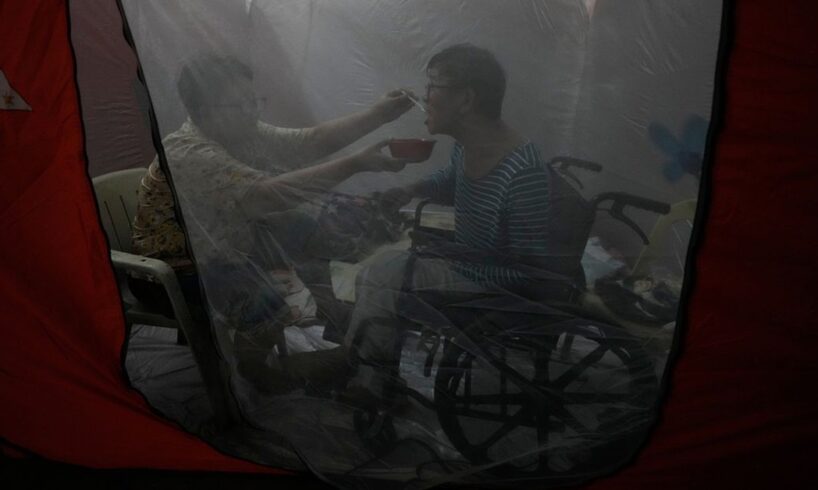
Judy Bertuso, 63, leans forward inside a bright orange tent set up on the floor of a basketball court in Quezon City, carefully spooning porridge into her husband Apollo’s mouth.
Apollo, 65, sits in a wheelchair as he recovers from a stroke, his frail frame outlined against the translucent plastic walls of the tent. Judy, in a wrinkled T-shirt and shorts, holds a bowl beneath the spoon as she feeds him.
She looks tired but unhurried, her movements deliberate, tender — the kind that comes from a lifetime spent caring for each other.
Judy Bertuso, left, feeds her husband, Apollo, inside a tent at an evacuation centre as Typhoon Fung-wong enters the country on Sunday, November 9, 2025 in Quezon city, Philippines. (AP Photo/Aaron Favila)
They had left their creekside home on Saturday, afraid it would flood again as Super Typhoon Fung-wong loomed. Their house was inundated during heavy rains in October. And when radio and television warnings urged residents to move to higher ground ahead of the storm, they didn’t wait.
Inside the basketball court, dozens of families occupy rows of bright tents. The wind howls outside. Inside, the hum of quiet conversations drifts from tent to tent, punctuated by the loud play and chatter of children.
Amid the noise and the uncertainty, Judy steadies the spoon again, her hand trembling slightly as she feeds Apollo, as if to say: The storm may rage beyond these walls, but care endures here.
Fung-wong makes landfall, forces 1 million to evacuate
Fung-wong, biggest typhoon to threaten the Philippines in years, slammed ashore on Sunday (early Monday AEDT) on the north-eastern coast of the Philippines, where the massive storm had already left at least two people dead and forced more than a million people to evacuate from flood- and landslide-prone areas, officials said.
The typhoon blew into Dinalungan town in Aurora province Sunday night after setting off fierce rain and wind in northeastern Philippine provinces all day from offshore, with sustained winds of up to 185 km/h and gusts of up to 230 km/h.
Judie Delector, right, and his family stay inside a tent at an evacuation centre as Typhoon Fung-wong enters the country on Sunday, November 9, 2025, in Quezon city, Philippines. (AP Photo/Aaron Favila)Fung-wong could cover two-thirds of the archipelago with its 1800-kilometre-wide rain and wind band, forecasters said. It approached from the Pacific while the Philippines was still dealing with the devastation wrought by Typhoon Kalmaegi, which left at least 224 people dead in central provinces on Tuesday before pummelling Vietnam, where at least five were killed.
A villager drowned in flash floods in the eastern province of Catanduanes and another died in Catbalogan city in eastern Samar province when she was pinned by debris, officials said.
Philippine President Ferdinand Marcos jnr has declared a state of emergency due to the extensive devastation caused by Kalmaegi and the expected calamity from Fung-wong, which is also called Uwan in the Philippines.
Tropical cyclones with sustained winds of 185 km/h or higher are categorised in the Philippines as a super typhoon, a designation adopted years ago to underscore the urgency tied to more extreme weather disturbances.
Philippine Coast Guard rescuers evacuate people to safer grounds in Quezon province, eastern Philippines as Typhoon Fung-wong enters the country on Sunday, November 9. 2025. (Philippine Coast Guard via AP)
“The rain and wind were so strong there was nearly zero visibility,” Roberto Monterola, a disaster-mitigation officer for Catanduanes, told The Associated Press by telephone.
Despite calls for residents to evacuate Saturday, some still stayed on.
“Our personnel rescued 14 people who were trapped on the roof of a house engulfed in flood in a low-lying neighbourhood,” Monterola said.
“A father also called in panic, saying the roof of his house was about to be ripped off by the wind. We saved him and four relatives.”
More than a million people were moved away from high-risk villages in northeastern provinces, including in Bicol, a coastal region vulnerable to Pacific cyclones and mudflows from Mayon, one of the country’s most active volcanoes.
Members of the Philippine Coast Guard clear fallen trees in Virac, Catanduanes as Typhoon Fung-wong affects the country, on Sunday, November 9, 2025. (Philippine Coast Guard via AP)
Defence Secretary Gilberto Teodoro jnr warned about the potentially catastrophic impact of Fung-wong in televised remarks Saturday. He said the storm could affect a vast expanse of the country, including Cebu, the central province hit hardest by the previous typhoon, and metropolitan Manila, the densely populated capital region.
More than 30 million people could be exposed to hazards posed by Fung-wong, the Office of Civil Defence said.
Teodoro asked people to follow government orders and seek shelter away from villages and towns prone to flash floods, landslides and coastal tidal surges.
“We need to do this because when it’s already raining or the typhoon has hit and flooding has started, it’s hard to rescue people,” Teodoro said.
Philippine Coast Guard rescuers evacuate residents to safer grounds in Laurel, Batangas province, Philippines as Typhoon Fung-wong affects the country, on Sunday, November 9, 2025. (Philippine Coast Guard via AP)
Power cut in eastern towns
The Philippines has not called for international help following the devastation caused by Kalmaegi, but Teodoro said the US, the country’s longtime treaty ally, and Japan were ready to provide assistance.
As Fung-wong approached with its wide band of fierce wind and rain, several eastern towns and villages lost power, Bernardo Rafaelito Alejandro, deputy administrator of the Office of Civil Defence said.
Authorities in northern provinces that could be hit or sideswiped by Fung-wong preemptively shut schools and most government offices on Monday and Tuesday. At least 325 domestic and 61 international flights have been cancelled over the weekend and into Monday, and more than 6600 commuters and cargo workers were stranded in seaports, where the coast guard prohibited ships from venturing into rough seas.
Authorities warned of a “high risk of life-threatening and damaging storm surge” of more than three metres along the coasts of more than 20 provinces and regions, including metropolitan Manila.
The Philippines is battered by about 20 typhoons and storms each year. The country also is often hit by earthquakes and has more than a dozen active volcanoes, making it one of the world’s most disaster-prone countries.





